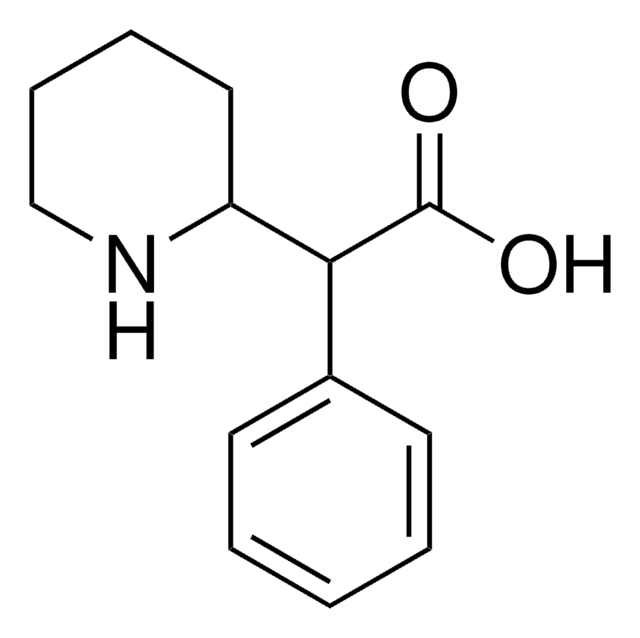R-011
Ritalinsäure -hydrochlorid -Lösung
1.0 mg/mL in methanol (as free base), ampule of 1 mL, certified reference material, Cerilliant®
About This Item
Empfohlene Produkte
Qualität
certified reference material
Form
liquid
Leistungsmerkmale
Snap-N-Spike®/Snap-N-Shoot®
Verpackung
ampule of 1 mL
Hersteller/Markenname
Cerilliant®
Konzentration
1.0 mg/mL in methanol (as free base)
Methode(n)
gas chromatography (GC): suitable
liquid chromatography (LC): suitable
Anwendung(en)
forensics and toxicology
Format
single component solution
Lagertemp.
−20°C
SMILES String
Cl.OC(=O)C(C1CCCCN1)c2ccccc2
InChI
1S/C13H17NO2.ClH/c15-13(16)12(10-6-2-1-3-7-10)11-8-4-5-9-14-11;/h1-3,6-7,11-12,14H,4-5,8-9H2,(H,15,16);1H
InChIKey
SCUMDQFFZZGUQY-UHFFFAOYSA-N
Allgemeine Beschreibung
Anwendung
- Genotoxicity research in non-human primates: Ritalinic acid hydrochloride, a primary metabolite of methylphenidate, is used in genetic toxicology studies to evaluate potential genotoxic effects, aiding in the assessment of safety profiles for neuropharmacological treatments (Morris et al., 2009).
- Pharmacokinetics and mutagenicity studies: Ritalinic acid hydrochloride is used in dose-range and mutagenicity research. It helps in studying the pharmacokinetics and toxicological impact of methylphenidate, offering important insights into its safety and effectiveness in therapeutic applications (Manjanatha et al., 2008).
- Bioequivalence and food effect studies: In clinical pharmacology, ritalinic acid hydrochloride is instrumental in conducting bioequivalence studies of dexmethylphenidate, examining the influence of food on drug absorption and metabolism, crucial for optimizing drug administration protocols (Teo et al., 2004).
- Childhood pharmacotherapy: Research using ritalinic acid hydrochloride explores the effects of methylphenidate when administered with or without food, highlighting its impact on the plasma concentration of the drug and its acid metabolite, informing pediatric dosing guidelines (Chan et al., 1983).
- Hyperkinetic disorders treatment studies: Ritalinic acid hydrochloride supports pharmacokinetic studies in children with hyperkinetic disorders, aiding in understanding how methylphenidate behaves within the body to improve therapeutic strategies (Hungund et al., 1979).
Rechtliche Hinweise
Ähnliches Produkt
Signalwort
Danger
H-Sätze
Gefahreneinstufungen
Acute Tox. 3 Dermal - Acute Tox. 3 Inhalation - Acute Tox. 3 Oral - Flam. Liq. 2 - STOT SE 1
Zielorgane
Eyes,Central nervous system
Lagerklassenschlüssel
3 - Flammable liquids
WGK
WGK 2
Flammpunkt (°F)
49.5 °F - closed cup
Flammpunkt (°C)
9.7 °C - closed cup
Analysenzertifikate (COA)
Suchen Sie nach Analysenzertifikate (COA), indem Sie die Lot-/Chargennummer des Produkts eingeben. Lot- und Chargennummern sind auf dem Produktetikett hinter den Wörtern ‘Lot’ oder ‘Batch’ (Lot oder Charge) zu finden.
Besitzen Sie dieses Produkt bereits?
In der Dokumentenbibliothek finden Sie die Dokumentation zu den Produkten, die Sie kürzlich erworben haben.
Unser Team von Wissenschaftlern verfügt über Erfahrung in allen Forschungsbereichen einschließlich Life Science, Materialwissenschaften, chemischer Synthese, Chromatographie, Analytik und vielen mehr..
Setzen Sie sich mit dem technischen Dienst in Verbindung.











